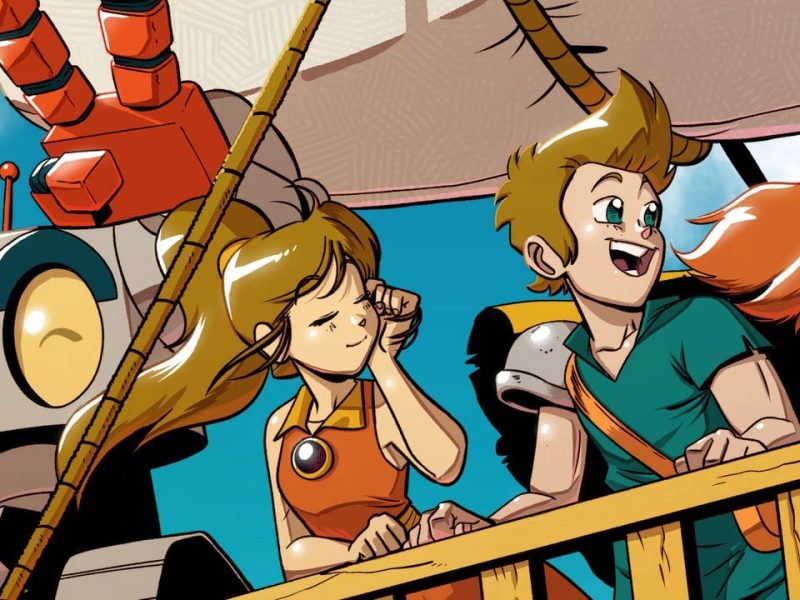Last year saw the remake of Live A Live launch on Nintendo Switch, some 27 years after its original 1994 launch on the Super Famicom. This marks the first time the title has been made available outside of Japan, and now that it’s coming to PS5 and PS4, we’re happy to report that Live A Live is still a unique and ground-breaking experience.
Straightaway, the game presents you with a choice of seven characters to play as, each spanning a different time period. There’s Pogo of the prehistoric era, Masaru Takahara of the present day, Cube of the distant future, and others in between. Choosing one of these characters won’t lock you into playing the whole game as them, instead simply offering a starting point. Each of these seven characters has a small chapter, easily completed in a maximum of three hours, which forms the wider game — and there’s no set order you need to play them in.
You might expect each of these chapters to be the same thing, repackaged to fit a new time period — but that isn’t the case at all. Each of the characters has their own individual personalities and oftentimes abilities. Prehistoric Pogo has no verbal skills, communicating with his peers in a series of grunts, but he has an impeccable sense of smell which can be used to track enemies. Akira of the near future can read minds, and Oboromaru of Edo Japan can turn invisible using his Shroud of Shadows. Each chapter has a different storyline, with a hint of a connection that will make itself apparent in the final chapter of Live A Live. Some chapters feel like a completely different genre, most notably Present Day where the entire thing is set up as a Street Fighter-esque fighting game. It makes for a really interesting experience, allowing each chapter to be memorable.

Live A Live also has the benefit of being able to dip in and out of chapters if you feel you’re not gelling with something. While all chapters will have to be completed in order to unlock the endgame paths, just because you start a chapter it doesn’t mean you’re locked into it until you finish. You’re able to exit to the menu and start or resume a different chapter, and the game will remember your progress in the timeline you’re leaving. A great touch for when you feel like something different.
It’s the eighth chapter where everything comes together, and the loose narrative thread that’s been woven throughout the other chapters finally becomes apparent.
A lot of the chapters are more straightforward than others, with some feeling particularly puzzling and vague. Edo Japan has its main character Oboromaru traversing what feels like an enormous maze of a palace, with many puzzles and traps to figure out. Conversely, the Prehistoric chapter is extremely linear in its progression with no room for doubt about where you need to go.
It’s small things like this that really make Live A Live stand out. Yes, this is a game separated into cohesive chunks, but it also feels like a series of smaller games which are part of a larger whole. There’s a certain charm to this that feels like you’re in for a totally unique experience — even here in 2023. Our favourite chapter, The Wild West, has its protagonist collecting items, and the inhabitants of a town setting traps for the outlaws who are about to attack. Depending on how many traps you successfully set within a certain time limit, this has a knock-on effect with how many enemies you’ll face in the final battle. It’s a really fun mechanic that we’ve rarely experienced before, and really makes that particular story stand out.

With updated HD-2D graphics, Live A Live features a recreated soundtrack from its original composer, Yoko Shimamura. Breaching multiple time periods, the soundtrack manages to brilliantly evoke the era you’re playing in, while also managing to sound cohesive when taken as a whole across the timeline. It’s a wonderful enhancement to the experience.
Combat-wise, Live A Live feels like familiar ground. Taking place on a grid, each character has a gauge which must be filled up before an attack can be unleashed. Moving around the grid fills up your enemy’s gauge, preparing their attacks, but some of your own techniques may delay or interrupt their plans. Each attack has a different area of effect, meaning you’ll have to position yourself just right in order to maximise damage across multiple enemies, or to ensure you’re hitting anyone in the first place. Enemies have different weaknesses and resistances which are easily seen by targeting them, so you can plan attacks accordingly by using different moves with different attributes. It’s all fairly fun, but the battle system doesn’t stand out or feel unique — especially when compared to how engaging the rest of the game’s design is.
Conclusion
Live A Live is an incredibly interesting and unique JRPG experience. With lovely HD-2D graphics and numerous main characters, it’s hard not to compare it to the likes of Octopath Traveler, but it really is a completely different kettle of fish. Live A Live is a varied thrill ride that still impresses all these years later, and while the combat does struggle to live up to the rest of the adventure, the game does a fantastic job of tying all of its intriguing, individual stories together. It’s a history-hopping journey we’ll be thinking about for quite some time.


